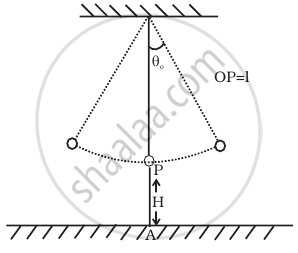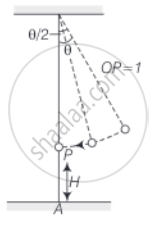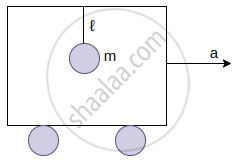Advertisements
Advertisements
Question
A simple pendulum of time period 1s and length l is hung from a fixed support at O, such that the bob is at a distance H vertically above A on the ground (Figure). The amplitude is θ0. The string snaps at θ = θ0/2. Find the time taken by the bob to hit the ground. Also find distance from A where bob hits the ground. Assume θo to be small so that sin θo = θo and cos θo = 1.

Solution
Consider the diagram,

Let us assume t = 0 when θo = θo, then θ = θ0 cos ωt
Given a seconds pendulum ω = 2π
⇒ θ = θ0 cos 2πt ......(i)
At time t1 let θ = θ0/2
∴ cos 2πt1 = 1/2
⇒ `t_1 = 1/6` ......`[∵ cos 2πt_1 = cos π/3 = 2πt_1 = π/3]`
`(dθ)/(dt) = - (θ_0 2π) sin2πt` .....[From equation (i)]
At `t = t_1 = 1/6`
`(dθ)/(dt) = - θ_0 2π sin (2π)/6 = - sqrt(3)πθ_0`
A negative sign shows that it is going left.
Thus, the linear velocity is `u = - sqrt(3)πθ_0l` perpendicular to the string.
The vertical component is `u_y = - sqrt(3)πθ_0l sin (θ_0/2)`
And the horizontal component is `u_x = - sqrt(3)πθ_0l cos (θ_0/2)`
At the time it snaps, the vertical height is `H^' = H + l(1 - cos (θ_0/2))` ......(ii)
Let the time required for fall be t, then `H^' = u_yt + (1/2)gt^2` ......(Notice g is also in the negative direction)
or `1/2 gt^2 + sqrt(3)πθ_0l sin θ_0/2 t - H^'` = 0
∴ t = `(-sqrt(3)πθ_0l sin θ_0/2 +- sqrt(3π^2 θ_0^2 l^2 sin^2 θ_0/2 + 2gH^'))/g`
= `(-sqrt(3)πl θ_0^2/2 +- sqrt(3π^2 (θ_0^4/4)l^2 + 2gH^'))/g` ......`[∵ sin θ_0/2 ≃ θ_0/2 "for small angle"]`
Given that θ0 is small, hence neglecting terms of order `θ_0^2` and higher
`t = sqrt((2H^')/g)` .....[Fro, equation (iii)]
Now, `H^' = H + l(1 - 1)` ......[∴ cos θ0/2 = 1]
= H .....[From equation (ii)]
⇒ t = `sqrt((2H)/g)`
The distance travelled in the x-direction is uxt to the left of where the bob is snapped
X = Uxt = `sqrt(3) πθ_0l cos (θ_0/2) sqrt((2H)/g) s`
as θ0 is small ⇒ `cos (θ_0/2)` = 1
X = `sqrt(3) πθ_0l sqrt((2H)/g) = sqrt((6H)/g) θ_0lπ`
At the time of snapping the bob was at a horizontal distance of `l sin (θ_0/2) = l θ_0/2` from A.
Thus, the distance of bob from A where it meets the ground is `(lθ_0)/2 - X = (lθ_0)/2 - sqrt((6H)/g) θ_0 lpi`
= `θ_0 l(1/2 - pi sqrt((6H)/g))`
APPEARS IN
RELATED QUESTIONS
If the metal bob of a simple pendulum is replaced by a wooden bob of the same size, then its time period will.....................
- increase
- remain same
- decrease
- first increase and then decrease.
Answer the following questions:
What is the frequency of oscillation of a simple pendulum mounted in a cabin that is freely falling under gravity?
A simple pendulum of length l and having a bob of mass M is suspended in a car. The car is moving on a circular track of radius R with a uniform speed v. If the pendulum makes small oscillations in a radial direction about its equilibrium position, what will be its time period?
A mass attached to a spring is free to oscillate, with angular velocity ω, in a horizontal plane without friction or damping. It is pulled to a distance x0 and pushed towards the centre with a velocity v0 at time t = 0. Determine the amplitude of the resulting oscillations in terms of the parameters ω, x0 and v0. [Hint: Start with the equation x = acos (ωt+θ) and note that the initial velocity is negative.]
Define practical simple pendulum
If the particle starts its motion from mean position, the phase difference between displacement and acceleration is ______.
Which of the following statements is/are true for a simple harmonic oscillator?
- Force acting is directly proportional to displacement from the mean position and opposite to it.
- Motion is periodic.
- Acceleration of the oscillator is constant.
- The velocity is periodic.
When will the motion of a simple pendulum be simple harmonic?
The length of a second’s pendulum on the surface of earth is 1 m. What will be the length of a second’s pendulum on the moon?
A pendulum of mass m and length ℓ is suspended from the ceiling of a trolley which has a constant acceleration a in the horizontal direction as shown in the figure. Work done by the tension is ______.
(In the frame of the trolley)

